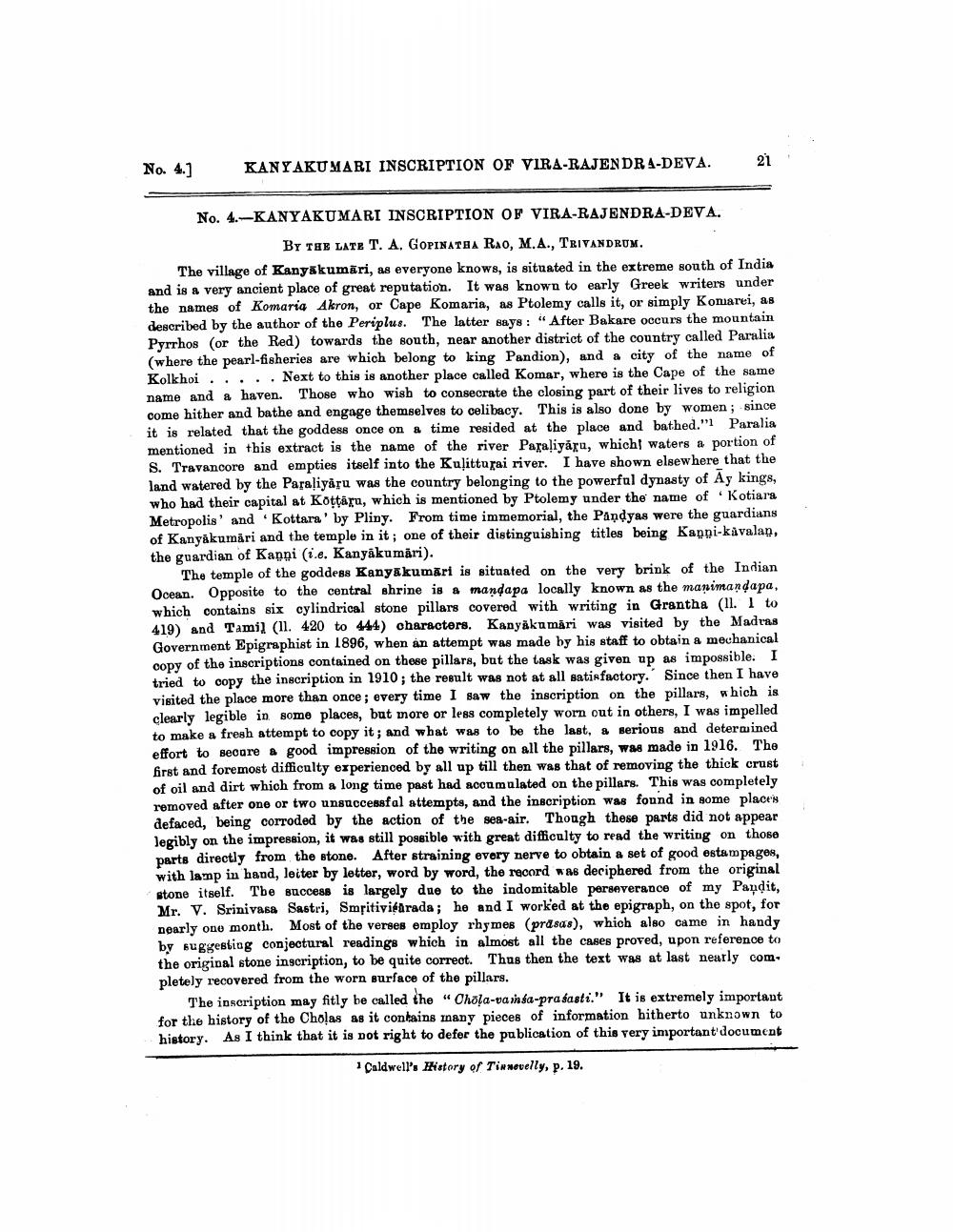________________
No. 4.]
KANYAKUMARI INSCRIPTION OF VIRA-RAJENDRA-DEVA.
21
No. 4.-KANYAKUMARI INSCRIPTION OF VIRA-RAJENDRA-DEVA.
BY THE LATE T. A. GOPINATHA RAO, M.A., TRIVANDRUM. The village of Kanyakumiri, as everyone knows, is situated in the extreme south of India and is a very ancient place of great reputation. It was known to early Greek writers under the names of Komaria Akron, or Cape Komaria, as Ptolemy calls it, or simply Komarei, as described by the author of the Periplus. The latter says: "After Bakare occurs the mountain Pyrrhos (or the Red) towards the south, near another district of the country called Paralia (where the pearl-fisheries are which belong to king Pandion), and a city of the name of Kolkhoi ..... Next to this is another place called Komar, where is the Cape of the same name and a haven. Those who wish to consecrate the closing part of their lives to religion come hither and bathe and engage themselves to celibacy. This is also done by women; since it is related that the goddess once on a time resided at the place and bathed." Paralia mentioned in this extract is the name of the river Paraliyāru, which waters a portion of S. Travancore and empties itself into the Kuļitturai river. I have shown elsewhere that the land watered by the Paraliyaļu was the country belonging to the powerful dynasty of Ay kings, who had their capital at Kottara, which is mentioned by Ptolemy under the name of Kotiara Metropolis' and Kottara' by Pliny. From time immemorial, the Pandyas were the guardians of Kanyakumari and the temple in it; one of their distinguishing titles being Kapni-kavalan, the guardian of Kapni (i.e. Kanyakumari).
The temple of the goddess Kanyakumari is situated on the very brink of the Indian Ocean. Opposite to the central shrine is a mandapa locally known as the manimandapa, which contains six cylindrical stone pillars covered with writing in Grantha (ll. I to 419) and Tamil (11. 420 to 444) characters. Kanyakumari was visited by the Madras Government Epigraphist in 1896, when an attempt was made by his staff to obtain a mechanical copy of the inscriptions contained on these pillars, but the task was given up as impossible. I tried to copy the inscription in 1910; the result was not at all satisfactory.' Since then I have visited the place more than once; every time I saw the inscription on the pillars, which is clearly legible in some places, but more or less completely worn out in others, I was impelled to make a fresh attempt to copy it; and what was to be the last, & serious and determined effort to secure a good impression of the writing on all the pillars, was made in 1916. The first and foremost difficulty experienced by all up till then was that of removing the thick crust of oil and dirt which from a long time past had accumulated on the pillars. This was completely removed after one or two unsuccessfal attempts, and the inscription was found in some places defaced, being corroded by the action of the sea-air. Though these parts did not appear legibly on the impression, it was still possible with great difficulty to read the writing on those parts directly from the stone. After straining every nerve to obtain a set of good estampages, with lamp in hand, leiter by letter, word by word, the record was deciphered from the original stone itself. Tbe success is largely due to the indomitable perseverance of my Pandit, Mr. V. Srinivasa Sastri, Smritivigirada; he and I worked at the epigraph, on the spot, for Dearly one month. Most of the verses employ rhymes prasas), which also came in handy by suggesting conjectural readings which in almost all the cases proved, upon reference to the original stone inscription, to be quite correct. Thus then the text was at last nearly com, pletely recovered from the worn surface of the pillars.
The inscription may fitly be called the “Chola-va insa-prasasti." It is extremely important for the history of the Cholas as it contains many pieces of information hitherto unknown to history. As I think that it is not right to defer the publication of this very important document
Caldwell's History of Tirnovelly, p. 19.




